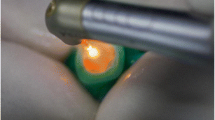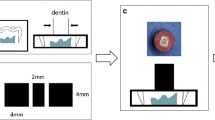Abstract
Objective
The study aimed to evaluate the bond strength of universal adhesives to dentin after Er,Cr:YSGG laser irradiation with nanosecond-domain and microsecond-domain pulses.
Methods
Eighty extracted caries-free, sound human molars were divided into eight groups. The enamel was removed until the dentin occlusal flat dentin surface was exposed. Etch-and-rinse followed by adhesive was applied to group 1, and a self-etch adhesive was applied to group 2. Er,Cr:YSGG laser (3 mJ, 100 Hz, 100 ns), (3 mJ, 100 Hz, 150 μs), and (20 mJ, 100 Hz, 150 μs) were applied to groups 3–4, 5–6, and 7–8, respectively. The laser preparation was followed by self-etch adhesives or adhesives treatment. When the composite resin had been built up on the samples, the shear bond strength was tested, and the data were statistically analyzed using analysis of variance (ANOVA).
Results
Groups prepared with nanosecond-pulse laser showed significantly higher bond strength values than the microsecond-pulse laser groups and self-etch mode group, and the SEM photographs also showed more dentinal tubules and no damage in the ablation area. The shear bond strength of long pulse laser ablated was comparable to that of self-etching system when it was combined with a self-etch adhesive at low energy, but higher energy laser degraded shear bond strength.
Conclusions
The pulse width of Er,Cr:YSGG laser affects the bond strength, nanosecond pulses of laser irradiation without water cooling can enhance bond strength, but microsecond pulses of laser cannot enhance bond strength.




Similar content being viewed by others
References
Karakaya İ, Özberk T (2021) Optical changes of human dentin after non-vital bleaching and effect of Er, Cr:YSGG laser on micro-shear bond strength of a self-etch and an etch-and-rinse adhesive system. Lasers Med Sci 36:189–196. https://doi.org/10.1007/s10103-020-03075-2
Malekafzali B, Fekrazad R, Mirfasihi A, Saedi S (2015) Comparison of microtensile bond strength of a resin composite to enamel conditioned by acid etching and Er, Cr:YSGG laser in human primary teeth. Eur Arch Paediatr Dent 16(1):57–62. https://doi.org/10.1007/s40368-014-0149-5
Vergauwen TE, Michiels R, Torbeyns D et al (2014) Investigation of coronal leakage of root fillings after smear layer removal with EDTA or Er, Cr:YSGG laser through capillary flow porometry. Int J Dent 2014:593160. https://doi.org/10.1155/2014/593160
Eltayeb TM, Rami M et al (2021) Erbium, Chromium:yttrium–scandium–gallium–garnet laser for root conditioning and reduction of postoperative morbidity in the treatment of gingival recession defects: a randomized controlled clinical trial. Photobiomodulation, Photomedicine, and Laser Surgery 39(10):665–673. https://doi.org/10.1089/photob.2020.4918
Dunn WJ, Davis JT, Bush AC (2005) Shear bond strength and SEM evaluation of composite bonded to Er:YAG laser-prepared dentin and enamel. Dent Mater 21(7):616–624. https://doi.org/10.1016/j.dental.2004.11.003
Oliveira DC, Manhães LA, Marques MM, Matos AB (2005) Microtensile bond strength analysis of different adhesive systems and dentin prepared with high-speed and Er:YAG laser: a comparative study. Photomed Laser Surg 23(2):219–224. https://doi.org/10.1089/pho.2005.23.219
Cui Q, Wei M, Xiong Z et al (2020) Effects of dentin ablation by a q-switching er:ysgg laser with a high pulse repetition rate. Photobiomodulation, Photomedicine, and Laser Surgery 39(6):390–394. https://doi.org/10.1089/photob.2019.4797
Yuan F, Lv P, Wang D et al (2015) Controlling dental enamel–cavity ablation depth with optimized stepping parameters along the focal plane normal using a three axis, numerically controlled picosecond laser. Photomed Laser Surg 33(2):92–97. https://doi.org/10.1089/pho.2014.3840
Sun YC, Vorobyev A, Wang Y, Li H (2013) Influence of intrapulpal temperature when using femtosecond laser in specific parameters to prepare cavities in tooth enamel: an in vitro study. Journal of Peking University (Health Sciences) 45(2):286–290. https://doi.org/10.3969/j.issn.1671-167X.2013.02.024
Shinkai K, Takada M, Kawashima S et al (2019) Effects of the percentage of air/water in spray on the efficiency of tooth ablation with erbium, chromium: yttrium-scandium-gallium-garnet (Er, Cr:YSGG) laser irradiation. Lasers Med Sci 34:99–105. https://doi.org/10.1007/s10103-018-2607-5)
Yazici AR, Karaman E, Tuncer D, Berk G, Ertan A (2016) Effect of an Er, Cr:YSGG laser preparation on dentin bond strength of a universal adhesive. J Adhes Sci Technol 30(22):2477–2484. https://doi.org/10.1080/01694243.2016.1184812
Lima PL, Dias S, Milori C, et al (2018) Dentin pretreatment with Er:YAG laser and sodium ascorbate to improve the bond strength of glass fiber post [J]. Lasers Med Sci: 1–8. https://doi.org/10.1007/s10103-018-2579-5
Meister J, Franzen R, Forner K et al (2006) Influence of the water content in dental enamel and dentin on ablation with erbium YAG and erbium YSGG lasers. J Biomed Opt 11(3):34030. https://doi.org/10.1117/1.2204028
Buyukhatipoglu I, Ozsevik AS, Secilmis A, Usumez A (2016) Effect of dentin laser irradiation at different pulse settings on microtensile bond strength of flowable resin. Dent Mater J 35(1):82–88. https://doi.org/10.4012/dmj.2015-090
Rosa WL, Piva E, Silva AF (2015) Bond strength of universal adhesives: a systematic review and meta-analysis. J Dent 43(7):765–776. https://doi.org/10.1016/j.jdent.2015.04.003
Beer F, Buchmair A, Korpert W, Marvastian L, Wernisch J, Moritz A (2012) Morphology of resin-dentin interfaces after Er, Cr:YSGG laser and acid etching preparation and application of different bonding systems. Lasers Med Sci 27(4):835–841. https://doi.org/10.1007/s10103-011-0979-x
Ayar MK, Erdermir F (2018) Bonding strength of universal adhesives to Er, Cr:YSGG laser-irradiated dentin. Niger J Clin Pract 21(1):93–98. https://doi.org/10.4103/1119-3077.224792
Gutknecht N, Apel C, Schäfer C, Lampert F (2001) Microleakage of composite fillings in Er, Cr:YSGG laser-prepared class II cavities. Lasers Surg Med 28(4):371–374. https://doi.org/10.1002/lsm.1064
Berk N, Başaran G, Ozer T (2008) Comparison of sandblasting, laser irradiation, and conventional acid etching for orthodontic bonding of molar tubes. Eur J Orthod 30(2):183–189. https://doi.org/10.1093/ejo/cjm103
Ferreira LS, Apel C, Francci C, Simoes A, Eduardo CP, Gutknecht N (2010) Influence of etching time on bond strength in dentin irradiated with erbium lasers. Lasers Med Sci 25(6):849–854. https://doi.org/10.1007/s10103-009-0715-y
Kiomarsi N, Arjmand Y, Kharrazi Fard MJ, Chiniforush N (2018) Effects of erbium family laser on shear bond strength of composite to dentin after internal bleaching. Lasers Med Sci 9(1):58–62. https://doi.org/10.15171/jlms.2018.12
Dehghanian P, Shafiei F, Kianimanesh N (2021) Effect of Er:YAG laser and reduced time of acid etching on bond strength of self-adhesive resin cement to MTA and biodentine. Lasers Med Sci 12(36):1–5. https://doi.org/10.34172/jlms.2021.36
Elsahn NA, Elkassas DW, El-Damanhoury HM (2021) Influence of low-level laser modification and adhesive application mode on the bonding efficiency of universal adhesives to Er: YAG laser- ablated dentin. Lasers Med Sci 12(7):1–9. https://doi.org/10.34172/jlms.2021.07
Funding
This work was supported by the National Key Research and Development Plan (2018YFB0407204) of China.
Author information
Authors and Affiliations
Corresponding author
Ethics declarations
Ethics approval
Ethical approval was obtained from the Hefei Institutes of Physical Sciences, Chinese Academy of Sciences, China (No. SWYX-Y-2022–33).
Conflict of interest
The authors declare no competing interests.
Additional information
Publisher's note
Springer Nature remains neutral with regard to jurisdictional claims in published maps and institutional affiliations.
Rights and permissions
Springer Nature or its licensor holds exclusive rights to this article under a publishing agreement with the author(s) or other rightsholder(s); author self-archiving of the accepted manuscript version of this article is solely governed by the terms of such publishing agreement and applicable law.
About this article
Cite this article
Xiong, Z., Tu, S., Jiang, L. et al. Effect of nanosecond- and microsecond-pulse Er,Cr:YSGG laser ablation on dentin shear bond strength of universal adhesives. Lasers Med Sci 37, 3285–3290 (2022). https://doi.org/10.1007/s10103-022-03625-w
Received:
Accepted:
Published:
Issue Date:
DOI: https://doi.org/10.1007/s10103-022-03625-w




